Research shows genes could offer resistance to Campylobacter

Variation in the response of chickens to Campylobacter helps identify key genes that may provide resistance to infection.
Research has identified genes in chickens that could offer resistance to harmful bacterial commonly found in poultry and could inform ways to limit the risk of associated food poisoning in people.
The study, led by a team from the Roslin Institute, Edinburgh, has identified a large number of genes in chicken guts that may determine whether the birds are resistant to Campylobacter. The insights could inform research towards breeding birds that are less likely to carry Campylobacter bacteria and so limit the risk to poultry consumers.
Scientists tested the effects of Campylobacter infection on chickens that were bred to be resistant or susceptible to the bacteria. Analysis of gut tissue showed differences in activity of a large number of genes, including some involved in immunity, such as the so-called Major Histocompatibility Complex and antimicrobial peptides. The variation between these genes in susceptible and resistant chickens may partly explain their response to Campylobacter.
Professor Mark Stevens of the Roslin Institute said: “Campylobacter is present in more than half of chicken sold, representing a significant risk to consumers, and breeding poultry resistant to the bacteria is one potential way to tackle this. Our research is shedding light on how the genetic make up of chickens influences their response on the bacteria, which could inform ways to breed poultry resistant to Campylobacter and thereby improve food safety.”
Genetic insights could help tackle campylobacter in chicken
UK scientists claim they have identified regions in the genetic make-up of chickens that are linked to resistance to Campylobacter. Find out more…
Supermarkets improve on contamination
Meanwhile, the latest UK retail figures released show that on average, across all major supermarkets, around 1.6% of chickens tested positive for the highest level of contamination in the first quarter of this year – an improvement on the last set of results.
All 9 retailers achieved levels below the Food Standards Agency target of a 7% maximum of high contamination (more than 1000 cfu/g). The majority recorded levels that were lower than between October and December.
Aldi, Morrison and Waitrose didn’t record any high levels of the bug in their samples, while Asda and the Co-op and Lidl each recorded contamination in less than 2% of samples.
Sainsbury’s recorded a 2.4% rate – a significant decrease from 7.1% noted at the end of last year – while Marks and Spencer had 3 and 4% of its chickens that breached the 1000 cfu/g level.
• The Roslin Institute study was published in BMC Genomics – Transcriptomic analysis of caecal tissue in inbred chicken lines that exhibit heritable differences in resistance to Campylobacter jejuni – PubMed (nih.gov)
Join 31,000+ subscribers
Subscribe to our newsletter to stay updated about all the need-to-know content in the poultry sector, three times a week. Beheer
Beheer








 WP Admin
WP Admin  Bewerk bericht
Bewerk bericht